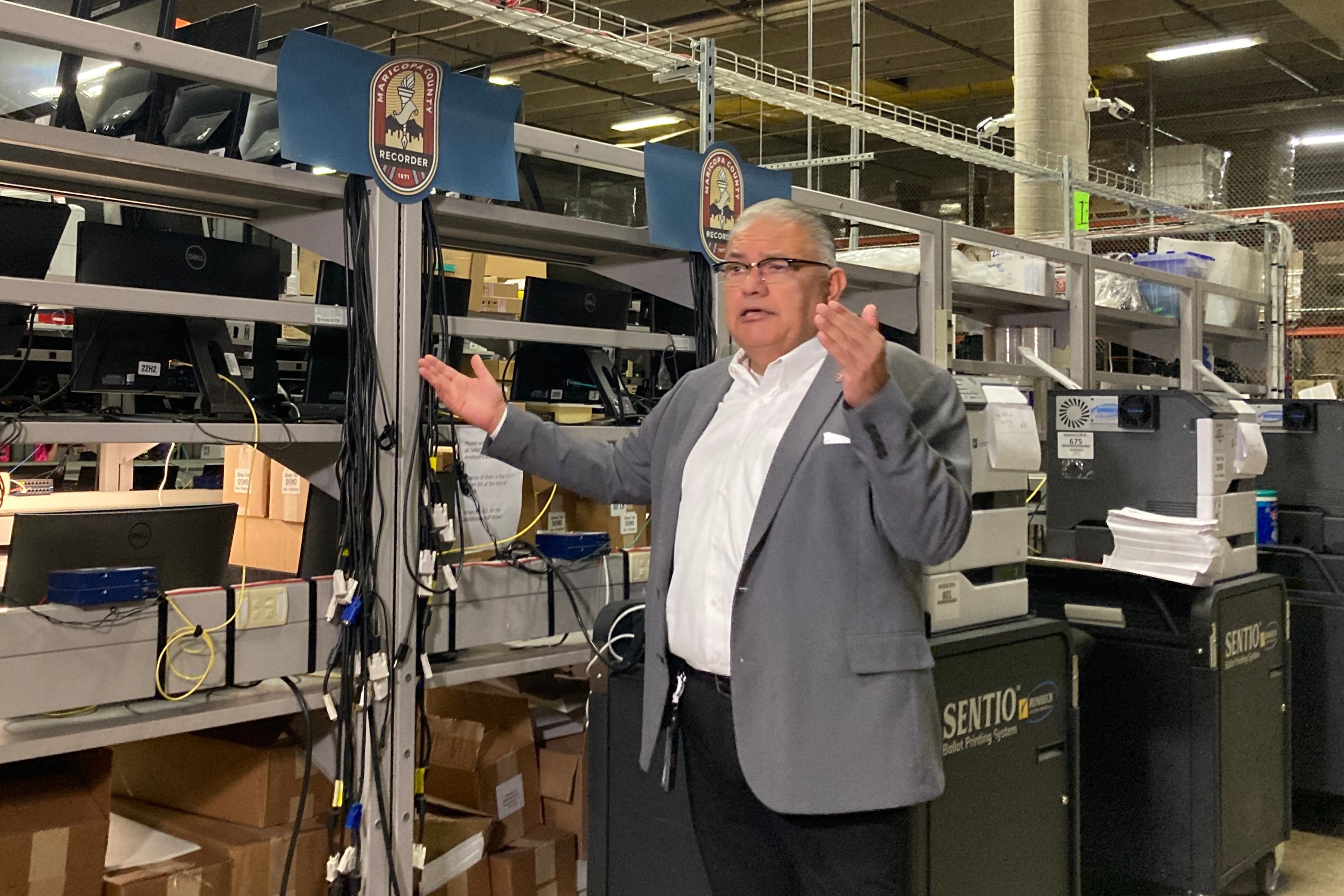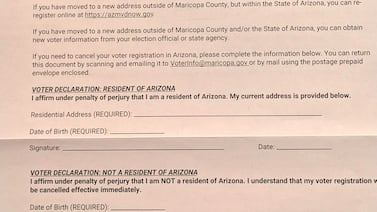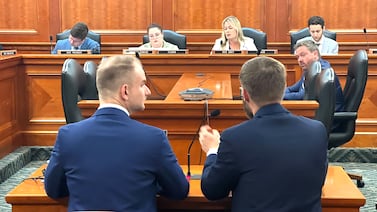Votebeat is a nonprofit news organization reporting on voting access and election administration across the U.S. Sign up for our free newsletters here.
After relying on retail-grade printers to print hundreds of thousands of ballots on the spot and then experiencing a countywide Election Day breakdown, Maricopa County is planning on spending millions to buy much larger, high-performance printers for each of its 2024 polling places.
To replace its faulty $300 OKI printers, Elections Director Scott Jarrett has chosen a new, $7,000 model of Lexmark printer the county has previously used at some polling places. It’s an expensive choice given the county’s size: With software and supplies, the grand total comes to $8.3 million.
County supervisors last week set aside $9 million to buy the new Lexmarks when tentatively approving next fiscal year’s budget, which begins July 1. Other than the budget approval, the county supervisors will not directly vote on the decision or the purchase. It isn’t subject to a competitive bidding or public process because the county has chosen to update its existing contract with its current equipment supplier, Runbeck Election Services, instead of approving a new one, according to elections department spokesperson Matt Roberts.
Maricopa County Supervisor Chairman Bill Gates said county officials are taking a holistic look at 2022’s ballot printer problem to ensure it doesn’t happen again.
“I’m confident we will make the right decision and there will have been the appropriate amount of time and study put into it,” Gates said.
As the county invests in an attempt to avoid future problems, election technology experts say that seeing such a large and sophisticated county experience major technological problems on Election Day amplified the need for more regulations and oversight of printers and other ancillary election equipment.
Ballot printers were “seen as a peripheral thing,” said Pam Smith, CEO of Verified Voting, a nonprofit which advocates for security in election technology. “But now there is more realization that this could actually have an impact on voters.”
No federal or state laws regulate which printers Arizona counties use to print ballots-on-demand for voters, or how the printers are tested.
Requiring ballot printers to be certified in Arizona, as other election equipment such as ballot tabulators are, would set standards for the printers and the testing of printers that might help prevent future problems, Smith said. Verified Voting, in a guide published last month, recommended that election officials set up rigorous pre-election testing focused on catching ballot printing errors prior to the 2024 election.
“If that technology is going to intersect with a voter at some point, and it has the impact on their ability to effectively cast a ballot … then you should probably test it, right?” Smith said.
Genya Coulter, a senior election analyst for the election technology and security nonprofit OSET Institute, is advocating for federal guidelines for ballot-on-demand printers.
As of now, ballot printers aren’t mentioned in the U.S. Election Assistance Commission’s guidelines for voting systems, which mainly includes the technology used to cast a vote, such as ballot tabulators and their software, ballot marking devices, and accessible voting machines. But the commission is studying adding other secondary equipment to the guidelines. These are voluntary guidelines, but some states, including Arizona, require voting systems to meet them to be certified by the state.
The nonprofit Center for Internet Security has also taken notice of the lack of standards for testing this secondary category of election technology — technology other than that used to cast, scan, or tabulate a ballot, said Jared Dearing, the organization’s senior director of elections best practices. Starting this fall, the group will offer a program to help election officials evaluate the security, accessibility, and usability of voter registration systems, voter check-in systems, and election night reporting systems. The plan is to add ballot-on-demand printers within the next two years, Dearing said.
“While non-voting systems have traditionally been seen as secondary to voting equipment, they are tremendously important to the successful administration of any election,” Dearing said.
The lack of regulations meant Maricopa County’s election officials had no guidelines when they retrofitted the OKI printers in 2020. The county had previously used those retail-grade printers, such as you might find at an Office Depot, to print ballot envelopes during early voting. When the county needed more printers, the OKIs were repurposed to print ballots on Election Day.
Those printers, though, weren’t equipped to print high-quality double-sided ballots on the thick and long cardstock used in November 2022, and print quality suffered, causing tabulators to reject ballots throughout the day in one-third of polling places. About 17,000 ballots that couldn’t be tabulated at polling places were eventually able to be tabulated by larger ballot tabulators at the county’s central elections center.
Maricopa County tested its printers before they were used, and had successfully used them in the 2020 election cycle and 2022 primary, but an independent review of what happened found that better testing, to simulate their heavy, intermittent use on Election Day, may have identified that they would fail when presented with a longer and thicker ballot in November.
Regulations fail to keep up with technology
Last year was only the second federal election cycle that the enormous county, with 250,000 in-person Election Day voters, tried to print and tabulate ballots on the spot.
In 2020, the county switched to an all “vote center” model, where voters can vote at any polling place instead of just the one in their precinct. That model requires counties to have an electronic voter check-in system and ballot printers at polling places so they can print on demand the correct style of ballot for each specific voter’s precinct. Even a voter from one neighborhood over might have different candidates on their ballot than a voter who lives next door to the polling place.
Maricopa County is one of the only large counties in the country that does it this way on Election Day, with most other large counties in states without all-mail elections either pre-printing ballots, tabulating them back at their central elections center, or both, according to a Votebeat analysis of information from Verified Voting and the National Conference of State Legislatures.
This on-the-spot process raises the stakes for technology to work correctly. It’s becoming more common across the country, as a growing number of places switch to a vote center model that’s intended to be more convenient for voters, less expensive, and more efficient for administrators.
That means the use of ballot-on-demand systems and electronic voter check-in systems, called e-poll books, is growing, while mostly remaining unregulated.
California requires counties to certify their ballot printers as part of their elections system, but it’s unclear if any other states do. Adding printers to the certification requirement would help counties by providing an approved equipment list as a starting point, Smith said.
Several California counties, in their requests for proposals for election equipment, outline specifically what the printer will need to be able to handle. A 2019 Orange County RFP, for example, asked companies to describe how their printers would hold up when used by more than 2,000 voters a day for 10 days.
“That would require some stress testing,” Smith said.
In Arizona, the Elections Procedures Manual, which has the force of law, requires counties that use ballot-on-demand printers to include ballots printed by the printers in the pre-election logic and accuracy test conducted by the secretary of state’s office, and requires general testing of the printers before each election, but the manual doesn’t offer specifics. The rest is up to the county.
Maricopa County isn’t the only place having ballot printing problems. A review by the OSET Institute this year, spurred by Maricopa County’s problems, found 80 instances of ballot printing errors across the country between 2020 and 2022, according to Coulter, who presented her findings at an election security conference earlier this year.
Coulter said that adding printers to the list of equipment that needs to be certified in each state ensures not only that the printer will work but that it will be safe from any potential tampering.
Maricopa County doesn’t have many printer choices
In Maricopa County, each Lexmark printer will come with software and supplies, with the package for each totaling $13,000. The county already has 165 Lexmark printers and will need 640 more, enough to have two or three at each of the about 250 polling places planned for 2024, Jarrett said.
If the county wasn’t updating its Runbeck contract, a purchase of this size would typically go through a public procurement process, required in the county for any purchase over $100,000.
The original Runbeck contract didn’t go out to bid in Maricopa County, either, because the county adopted a Pinal County contract and then modified it to meet its needs, Roberts said.
Even if the county did go out to bid for the printers, Runbeck CEO Jeff Ellington said he doesn’t believe there would be many companies competitive with Runbeck, given its location in Phoenix and size.
There aren’t many options for ballot printers, generally, Ellington said, but especially when ballots are double-sided and as long and thick as Maricopa County’s ballots, at 20 inches and 100-pound weight in November.
In 2024, the county might need an even longer, 22-inch ballot, given the expected number of contests, according to Jarrett, the county’s election director.
Hardly any printers can accurately print on both sizes of ballots up to 22 inches long, Ellington said. Printing ballots requires a precision not needed for other documents, because the ballot image has to be perfectly aligned on the paper and the toner has to be dark enough for the tabulator to accept them, Ellington said
In a laser printer like the OKIs the county was using, the printer needs to heat up the page enough for toner — powder that adheres to the paper to create the image — to stick properly, and to be dark. In November, the ballots didn’t get hot enough and the toner was too light for the tabulators.
Runbeck does comprehensive testing on new printers, printing thousands of ballots on different paper types, before it even offers them to customers. Runbeck did this for the OKIs that Maricopa County was using, and for the new Lexmarks, Ellington said.
Maricopa County has also just completed its own testing of the Lexmark, after borrowing one from Runbeck.
Ellington said he thinks the county is making the right choice in upgrading to the Lexmarks, especially given the turnout and long ballot expected in 2024.
“Next year has got to go really smoothly,” he said.
Jen Fifield is a reporter for Votebeat based in Arizona. Contact Jen at jfifield@votebeat.org.






